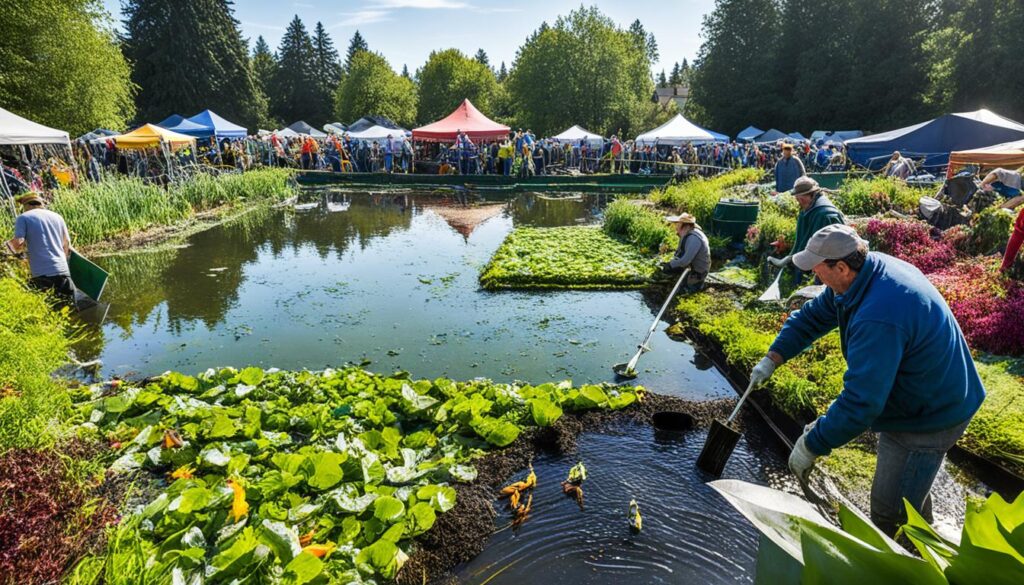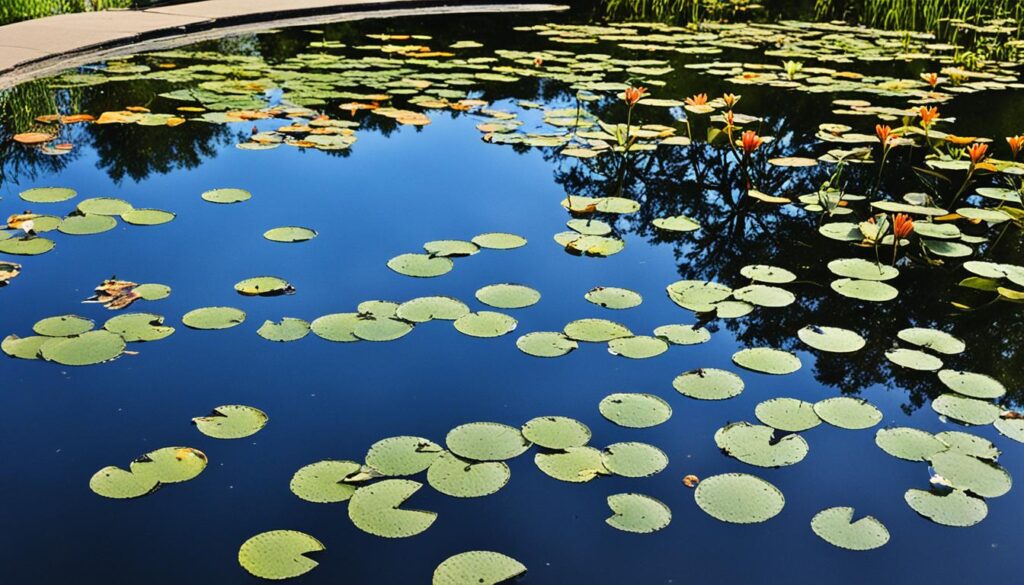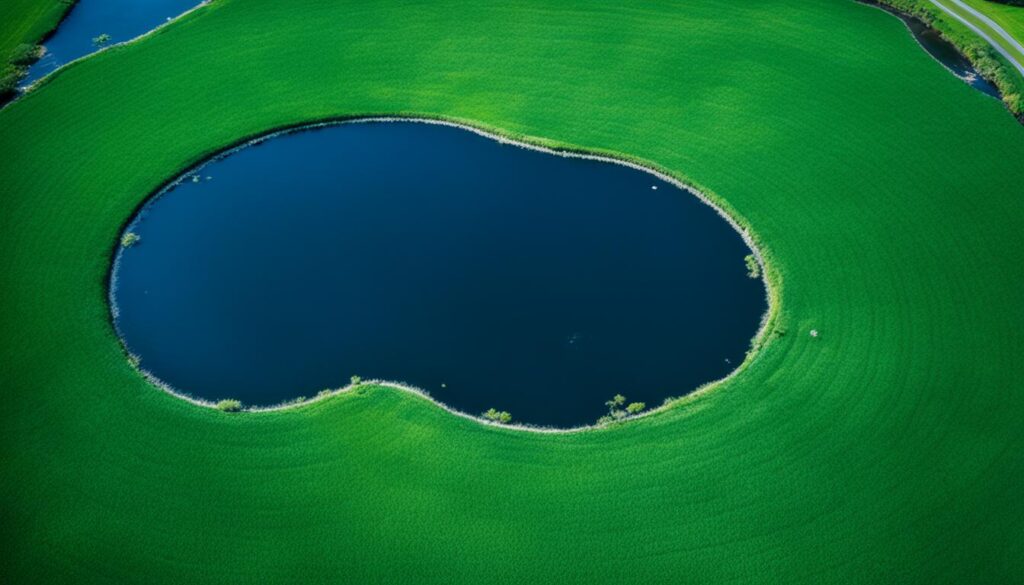Farmers markets are the heart of many communities, often featuring beautiful ponds. These ponds add charm and appeal. But, they need regular care, including liner replacement. What’s the best way to keep your pond thriving at the farmer’s market? Let’s look at the key steps for a smooth pond liner replacement.

Key Takeaways
- High-quality pond liners can maintain water quality and keep fish healthy
- Durable liners can increase a pond’s longevity by resisting weathering and erosion
- Proper liner installation and maintenance can minimize algae growth and reduce upkeep efforts
- Replacement is crucial as some plastic liners may not last even 10 years due to environmental factors
- Preparing the pond bed and choosing the right liner material are critical steps for a successful replacement
Why Pond Liners are Crucial for Farmers Market Ponds
Keeping a pond at a farmers market in good shape is key. Pond liners help by stopping water from leaking into the soil. This saves water and keeps the pond stable. They also keep invasive plants and algae away, which keeps the water clean and supports pond life.
Preventing Water Loss and Seepage
Pond liners stop water from leaking, a big problem for farmer’s market ponds. They are cheaper and easier to install than some other liners, making them a smart choice. By keeping the water level steady, they help the pond’s ecosystem stay balanced.
Maintaining Water Quality and Ecosystem Health
Pond liners also help keep the water clean and the pond healthy. They act as a barrier, keeping out harmful substances from the soil. This lets aquatic plants and animals flourish, making the pond a healthy place.
| Liner Material | Thickness | Weight | Puncture Resistance | Durability |
|---|---|---|---|---|
| RPE (Reinforced Polyethylene) | Half of EPDM and PVC | One-third of other liners | High | Up to 40 years |
| EPDM (Ethylene Propylene Diene Monomer) | – | Heaviest | Least puncture resistant | – |
| PVC | – | Heavier than RPE, but less than EPDM | More puncture resistant than EPDM, but less than RPE | – |
As shown in the table, different pond liners have different features. Farmers market managers should think about these when picking a liner for their pond.

Signs Your Farmers Market Pond Liner Needs Replacement
Keeping a pond healthy is key for any farmer’s market. But, your pond liner can wear out over time, showing it needs to be replaced. Let’s look at the main signs your pond liner needs attention.
Visible Damage and Leaks
Visible damage like cracks, tears, or holes means your pond liner needs replacing. These issues can cause water loss and harm the pond’s ecosystem. If you notice the water level dropping often, it could mean a leak in the liner.
Age and Deterioration
Pond liners don’t last forever, usually 10 to 20 years. When nearing the end of its life, it wears out and deteriorates. Replacing it before it fails can prevent problems and keep your pond healthy.
By watching for liner damage or aging, you can know when to replace it. This keeps your farmers market pond thriving and your outdoor space successful.
| Potential Pond Liner Issues | Causes and Impacts |
|---|---|
| Liner Damage | Holes from sharp tools, animals, or decorative elements Punctures and tears due to environmental exposure |
| Liner Floating | Rising groundwater, especially after heavy rain or in saturated soil |
| Liner Sagging | Debris accumulation and anaerobic bacterial growth Sulfuric odors from the pond Erosion of soil support |

By acting early and fixing these problems, you can keep your farmers market pond working well and looking great. This makes your pond a nice place for your community.
Choosing the Right Pond Liner Material
Choosing the right pond liner material is key for a long-lasting and eco-friendly pond. EPDM (Ethylene Propylene Diene Monomer) rubber liners, PVC (Polyvinyl Chloride) liners, and Reinforced Polyethylene (RPE) liners are top choices. Each has its own benefits and things to consider.
EPDM Rubber Liners
EPDM rubber liners are a top pick for many ponds. They are flexible, durable, and stand up well to the sun. EPDM liners last a long time in cold and sunny places. They fit ponds of all shapes and sizes and are easy to put in.
PVC Liners
PVC liners are a budget-friendly option that’s easy to install. But they’re not great for fish or plants because they can release harmful chemicals into the water. They’re okay for some uses but don’t last as long as EPDM or RPE liners.
Reinforced Polyethylene (RPE) Liners
Polyethylene liners are tough against punctures and come in big sizes for large ponds. RPE liners are very strong and won’t easily get punctured. They’re a good choice for big ponds. They cost more but last a long time and handle tough conditions well.
When picking a pond liner, think about what your pond needs and its environment. Using underlay materials and geotextiles can help prevent leaks and make your pond liner last longer.
| Liner Material | Key Features | Ideal Applications |
|---|---|---|
| EPDM Rubber | Flexible, durable, UV-resistant | Ponds of various sizes and shapes |
| PVC | Cost-effective, relatively easy to install | Limited to non-fish and plant-based ponds |
| Reinforced Polyethylene (RPE) | Highly durable, puncture-resistant, lightweight | Larger farmers market ponds |
Preparing for Farmers Market Pond Liner Replacement
Before you replace the pond liner at your local farmers market, make sure to prepare the site well. This means draining the pond and taking out the old liner. This ensures a smooth and successful setup of the new liner.
Draining the Pond and Removing Sludge
Begin by draining the pond with a submersible pump. This lets you clear out any sludge or debris at the pond’s bottom. It’s key for a clean and even surface for the new liner. Move any fish or plants to a safe tank during the replacement.
Removing the Old Liner
With the pond empty, it’s time to remove the old liner. Check for any sharp things or debris that could harm the new liner. Then, get rid of the old liner in an eco-friendly way, following your area’s rules.
Getting the pond ready for a new liner is crucial for a successful and lasting setup. This ensures your farmers market pond stays healthy for many years.
Age often leads to problems with spillways, especially those from the 1970s and 1980s. Steel standpipes can rust and leak, causing dam failures. Plastic pipes might leak if anti-sleep collars aren’t put in correctly. Sometimes, fixing a few parts isn’t enough; you might need to replace the whole system, which costs a lot. But natural spillways are a cheaper option. They can be lined with stones to stop erosion. A well-made and cared-for spillway can make the water cleaner, stop flooding, and make the pond look better.
Step-by-Step Guide to Installing a New Pond Liner
Replacing an old pond liner is key to keeping your farmer’s market pond healthy and long-lasting. After removing the old liner, prepare the pond bed for the new one. Follow these steps for a successful pond liner replacement.
Preparing the Pond Bed
Clean and smooth the pond bed before putting in the new liner. Remove debris, rocks, or sharp objects that could harm the new liner. Add sand or a special underlayment for extra protection. Think about flooding, groundwater, soil, gas buildup, and removing sharp objects when preparing.
Placing and Adjusting the New Liner
Unroll the new liner and put it in the pond, leaving some overlap at the edges. Use rocks or weights to hold it in place while smoothing out wrinkles. Installing the liner means preparing anchor trenches, placing the liner, using sandbags, and welding seams.
Refilling the Pond and Securing the Edges
Fill the pond with water, adjusting the liner as it fills to smooth out any wrinkles. Once full, secure the liner edges with rocks, paving stones, or soil to keep it in place. Check the liner for defects or holes and mark areas for repair if needed.
By following these steps, you’ll get a new pond liner that keeps water in and protects your pond’s health. HDPE liners are very durable and last a long time. They can be welded together to seal and save on shipping costs. HDPE liners are also very durable and can be welded for a strong seal. Using big rolls of liner for big ponds cuts down on welds and time. HDPE liners can be welded at lower temperatures, making the process quicker. AGRU HDPE Smooth Liner meets high standards for pond lining, ensuring reliability.
Farmers Market Pond Liner Replacement
Keeping a farmers market pond looking good, with clear water and a healthy ecosystem, is key. Replacing the pond liner is a big step in making sure it lasts a long time.
Pond liners can last 10 to 20 years. Picking the right material is very important. EPDM rubber liners work well for ponds of all sizes and shapes. PVC liners are cheaper and easy to put in. For big ponds, RPE liners are the best choice because they’re strong and don’t tear easily, but they cost more.
Before putting in a new liner, you need to get the pond ready. This means draining it, cleaning out the sludge, and taking out the old liner. Doing this makes putting in the new liner go smoothly, saving water and cutting down on upkeep costs.
Checking and looking after the pond liner often is important for its life and the pond’s look. Keeping the water clean, which means stopping algae from growing, helps the liner last longer and keeps the pond’s ecosystem healthy.
Getting a new pond liner will make the farmers’ market better for visitors, bring in more people, and help local shops. A well-kept pond liner has many benefits, like being good for the environment and helping the local economy. It’s a smart move for any farmer’s market.
Maintenance Tips for Long-Lasting Pond Liners
To make sure your pond liner lasts a long time, follow a regular maintenance plan. Check the liner often for any damage and fix small problems quickly. Doing this can help avoid big repairs, with most pond liners needing less than 5% maintenance.
Regular Inspections and Debris Removal
It’s key to check your pond liner often. Look for any damage like cracks or tears and fix them fast. Also, remove things like leaves and branches to stop them from harming the liner.
Water Quality Management
Keeping the water in your pond clean is vital for the liner’s health. Test and balance the water chemistry and control algae to stop liner damage. If the liner gets damaged, figure out why and fix it right, maybe with a small patch or a full replacement.
Follow these maintenance tips to keep your pond liner working well for a long time. This way, your Farmers Market pond will stay beautiful and functional for years.
Conclusion
Replacing farmer’s market pond liners is key to keeping these water features beautiful and useful. This guide has shown you how to spot when you need a new liner and how to install it right. This way, your farmers market pond will stay a lively, healthy spot that makes the market look better.
Regular upkeep and managing water quality will make your pond liner last longer. This means you can enjoy your pond for many years. While some liners don’t last long, others like LDPE, HDPE, RPE, Polyethylene, and PVC can last 20 years or more if you heat-weld them.
Choosing a top-notch liner like BTL Liner’s RPE AquaArmor, which fights off UV rays, will keep your pond looking great for years. Taking good care of your pond liner and keeping the water clean are the secrets to making the most of this important spot for your farmers market.
FAQ
What are the signs that my farmers market pond liner needs replacement?
Look for visible damage like cracks, tears, or holes. Also, check for constant water loss or leaks. If the liner is over 10-20 years old, it’s time to replace it.
What are the different types of pond liner materials to choose from?
You can pick from EPDM rubber liners, PVC liners, and Reinforced Polyethylene (RPE) liners. EPDM is flexible, durable, and resists UV damage. PVC is cheaper but not as long-lasting. RPE is great at preventing punctures but costs more.
How do I properly prepare the pond for liner replacement?
Start by draining the pond completely. Then, remove any fish or plants. Clear out all sludge and debris. Finally, take out the old liner and make sure the pond bed is smooth and free of sharp objects before installing the new one.
What is the process for installing a new pond liner?
First, prepare the pond by draining it and removing any fish or plants. Clear out debris and take out the old liner. Place the new liner in the pond, smooth out any wrinkles, and slowly refill it. Secure the liner edges with rocks, pavers, or soil for a natural look.
How can I maintain my newly installed pond liner to extend its lifespan?
Keep an eye on your pond by regularly checking for debris and removing it. Manage water quality well. Fix any small issues quickly to avoid big problems later and keep the liner in good shape.